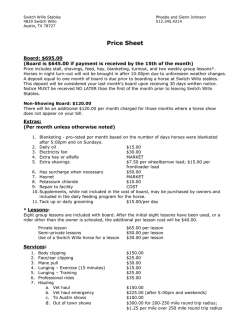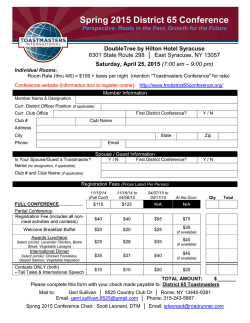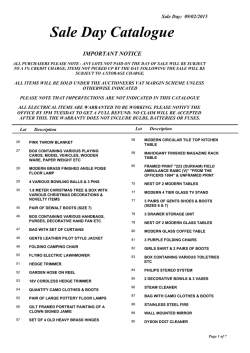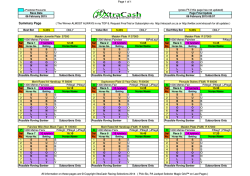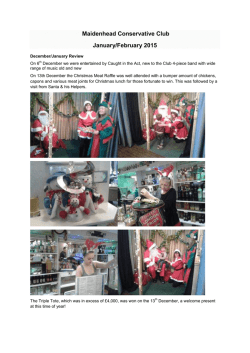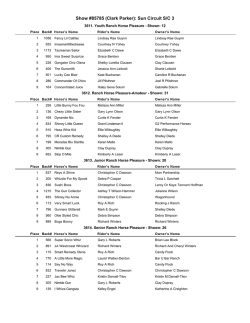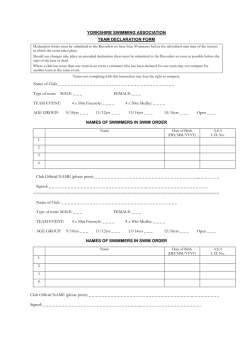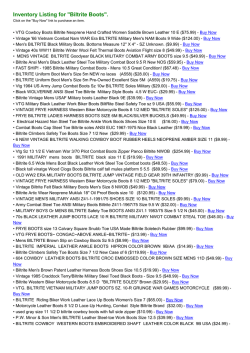
The Trail New s - Blue Spruce Riding Club
Letter from the Editor email—[email protected] www.bluespruceridingclub.com The Trail News BLUE SPRUCE RIDING C LUB January 2015 This coming year Blue Spruce would like to expand on our new Obstacle Challenge and will be working on designing new ones for our fall show. We will be planning a few of the 2nd Saturdays of the month to practice them. Check back later for the dates. You may want to check out the Trail Challenge that is going to be held at the PA Horse Expo in March. Maybe we can get a few ideas from there. The topic of having a trail obstacles clinic at the club ground was brought up and we will be checking into that. We are going to have the Tack Swap and our Spring Horse Show on the same Sunday in May again this year. It worked out well last year and brought people together on the same day for our two events. A win—win for both. We will be asking our members to get us show sponsors , this helps by advertising for them and helps with show expenses. We need to get other suggestions from you— our members for what you want to do this year. If there are other places you want to ride, help us out with that and we will give it a try. Any input from our membership is appreciated. Don’t forget to send in your 2015 dues or bring them along to the February meeting at the Starlite Diner. Hope to see you all there. Remember to check in with a club officer if the weather is bad. See you on the trail…. Remember it isn’t the destination, it’s the ride. Inside this issue: Important Upcoming Events!! 2 Club Officers 2015 2 Save-a-Tape Info 2 Jan General Meeting 3-4 Cancelled due to weather Winter Turnout 5 Treasurer’s Report: Confident Riders 6 Advertising 7 Club Meeting Schedule—2015 8 Tips on Cleaning Tack Checking—$833.23 Savings—$2,873.19 Total—$3,706.42 Upcoming Events 2ND Saturdays of the Month—The ring at the club grounds will be open for use—only in good weather. If you are interested in using the ring that day—please contact Alice Bastian at 610-298-8236. We ask that if you use the ring, please clean up after yourself. PLEASE NOTE: A couple of these Saturdays we will have obstacles setup for you to practice—dates to be determined yet. February Meeting will be held a the Starlight Diner in Fogelsville. Come out at 6:00 pm for dinner and 7:00 pm for meeting. March 5th—8th—Horse World Expo: he PA Horse World Expo will bring the nation’s leading equestrian clinicians and entertainers to Harrisburg for four days of education, entertainment and shopping. - Top equestrian clinicians and performers. - Hundreds of vendors and equines of all breeds and disciplines. - Non-stop seminars, shopping and entertainment . Show Hours: Thursday: noon - 8 pm Friday: 10 am - 8 pm Saturday: 9 am - 8 pm Sunday: 9 am - 5 pm 2015 Membership Thank you to our members who faithfully mail in their dues each year. Membership dues are due in the beginning of each year. If you joined in Nov or Dec, of the previous year, no dues are required till the following year. The price is: $15.00 for a Single Membership and $20,00 for a Family Membership. If you need a membership application, it is posted on our website. Please send your dues or new membership application to : 2015 BLUE SPRUCE CLUB OFFICERS President: Alice Bastian—610-298-8236 2014 Board Members: Secretary: Donna Christ—610-432-1628 Pat Zentner—610-845-2205 Treasurer: Naomi Lawhorn—610-3235248 Tina Hunsicker—610-398-2257 Maintenance: Open Office Wayne Burrows—610-216-4365 Jean Hunsicker—610-608-5156 Show Chairman: Sue Moss—570-3450754 Newsletter Editor & Trail Boss— Charmaine Ropeter—610-754-7679 Webmaster: Theresa Reabold— 610-826-5309 Board of Directors 2015: Naomi Lawhorn at Chairman of the Board: RD 6, 1805 St Peters Rd. Doris Betzenberger—610-767-2346 Don’t forget we have free advertising in the newsletter for club members, just email the editor with the information or send a business card. We also provide free space for club members for items for sale or items in search of. Just forward the information to the editor. Pottstown, PA 19465 Redner’s Save A Tape Card To help us earn some income for our club, please, if you shop at Redner’s Warehouse Markets, sign up for the Save A Tape Card. All you need to do is go to the customer service desk and ask to sign up for the Save A Tape Card. Fill in your name and address and our Club Name. Present the card to the cashier each time you check out. Bring the tapes to the club meetings and give them to our Treasurer—Naomi Lawhorn. Please don’t roll the tapes up, no highlighters, and don’t tear anything off. Page 2 TH E TR A I L NE WS Tips on Cleaning Up Your Tack by Heather Smith Thomas Barns and stables, especially those with lesson and training programs, have a lot of leather lying around. And, as we all know, when cared for properly, leather is durable, strong and resilient. If allowed to become dirty, dry and brittle, though, its life can be drastically shortened. Since leather is a natural fiber, subject to damage from moisture, bacteria and high heat, it can easily break down if not protected from these elements. While there never seems to be enough hours in the day for added barn chores, keeping tack well-oiled and clean can save money in the long run. Here are a few tips for you and your clients to prolong the life of your equipment. According to Cary Schwarz, a saddlemaker in Salmon, Idaho, leather does better in a dry climate than a wet one because moisture and mildew are less of a problem. But regardless of climate, it is important to keep proper oil content in the leather. Clean the Leather “It’s always a good idea to clean a saddle or bridle before you oil it or use a conditioner,” said Schwarz. “Dirt, in my view, is even more destructive than moisture or heat. Many riders get in the habit of just putting some oil or a leather-conditioning product over the leather without cleaning it first, and that tends to fix the dirt onto the leather; it cakes on and is there to stay. A thorough cleaning should be the first order of business in leather care.” Cleaning the leather will also get rid of sweat. Any piece that comes into contact with the horse should be thoroughly washed, especially on the underside. Warmth and sweat from the horse carries with it all the salts from the sweat, and dirt from the horse’s body. Salt is very hard on leather. “You need to remove as much of that salt as you can, and float out the dirt particles, with saddle soap and warm water," said Schwarz. "Basically all you need for cleaning a saddle is saddle soap, a sponge, nylon bristle brush and some warm water. It only takes about 30 minutes to do a thorough washing on a saddle, using the brush to work up a lather on the leather with the soap and warm water, and the sponge to flush it clean. Washing with warm water opens the pores of the leather to float out dirt particles that have penetrated into it.” Proper care and maintenance of leather is often misunderstood. When cleaning leather, many people think that leather and water are a bad combination. “But water is hard on leather only if the leather is wet for an extended time,” explained Schwarz. “Many people just use a can of glycerine liquid saddle soap and spray it on, work up a lather and wipe it off—and never use any water—and this doesn’t remove all the dirt. And if you merely follow the directions on the label of a can of paste saddle soap, you have not cleaned the leather. It usually says something like ‘produce a lather and rub well into the leather.’ But all this does it just grind the dirt into the leather. It might work all right on a piece of tack that never gets very dirty, but with a saddle it is very critical to float those dirt particles out. “I often use a five-gallon bucket of warm water when cleaning a saddle, and depending on how dirty the saddle is, I might go through two or three bucketfuls of warm water," he explained. "If you use a big heavy sponge, this will get the water down into the seams and cracks, and wash some of the areas you can’t even see. “You shouldn’t dunk a saddle, but you should not be afraid of using water," he stressed. "Work up a good lather with the nylon bristle brush, and then flush it clean with warm water and a sponge. “If the leather is quite old, be very cautious about using too-warm water to clean it," Schwarz advised. "Warm water works well on newer leather, but you don’t ever want to use hot water, especially on old leath- Page 3 TH E TR A I L NE WS er that has been neglected. Hot water and old leather are like hot water and wool; it will shrink the leather. If there’s not enough oil in the leather, hot water will ruin it. “Other than that, the same recommendations apply for old or new leather; just clean it up really well, top and bottom, with warm water and then use oil and conditioner if it -hasn’t had oil for awhile,” he said. If it’s been awhile since a saddle or bridle was thoroughly cleaned, take it apart to clean it—in order to get all the dirt out from under the buckles, or from the inner parts of a saddle. Then you can tell if any of the leather is getting worn (as under a buckle) or parts of a saddle need to be replaced. Leather treads on the stirrups of a western saddle need to be thoroughly cleaned, especially if you’ve been getting on and off in the mud, or in a pen where there might be manure. Mud or manure on leather treads can be hard on them. Acid in manure will eat at the leather; if it’s not cleaned off the leather will deteriorate and eventually need to be replaced. After the cleaning, just let the saddle dry at room temperature. Now For The Oil After washing the tack you can go over the clean leather with a conditioner, oil or whatever you wish to use, after the leather has been allowed to dry. If the leather seems really dry and hard, use a very high grade of oil to replace what time and washing have removed. Oils should be used sparingly, however, unless the leather is quite dry. Over-oiling will add unnecessary weight to the leather and may also bleed out of the leather in hot weather, Schwarz said. Also, using too much oil can break down the leather fibers. In a wet or humid climate you might want to treat leather to prevent mildew. Rather than using just oil, it’s better to use a product that contains wax. “The wax will seal the leather much better and repel moisture," stated Schwarz. "I recommend using something like R.M. Williams Saddle Dressing (an Australian product), or Ray Holes Saddle Butter. You can use these products quite liberally all over the saddle. Anything that has a wax base will help create a moisture barrier. “If a saddle or bridle hasn’t been used for awhile, or has been in storage a long time, whatever oil it might have had may have dried out," he explained. "If the leather is really dry, I use 100% neatsfoot oil. You need to use some kind of thin, high-grade oil that will penetrate leather. “You’ll be able to tell how much oil to use, because dry leather will just drink it in. At room temperature indoors, or in warm sun (where the leather is warm) it will take in oil quite readily. It’s also best if the oil is warm. On the label it may recommend that you heat it to about 100 to 110 degrees, and that means it should feel warm to the touch. Even with new leather, I like to have the oil warm; it will dissipate into the leather fibers more readily. “After you oil it, let it sit for awhile," he said. "In a few hours, or the next day, feel the leather again. If it still feels brittle and dry, it needs more oil. If it feels pliable and ‘alive’ again, then that’s enough oil. “Then, after the leather is pliable again, you can go ahead and apply the saddle dressing or saddle butter to seal it and protect it better,” said Schwarz. As with oil, it’s best if both the wax and the leather are warm for optimal absorption. These products contain beeswax and other hard waxes, and if the leather is cold, the product will merely cake onto the outer surface rather than penetrate. It will take a lot more elbow grease to work it into the pores of cold leather than into warm leather that has more open pores. “To help break down the wax, I may use a blow dryer," noted Schwarz. "On a carved western saddle, especially, the wax product will tend to cake into the creases rather than be absorbed. But the dryer will warm it enough so it soaks right in. If you can get some penetration with the wax-based product, then when the leather cools the wax hardens. That’s how you get the sealing effect that works so well as a moisture barrier. “After that, I use a piece of soft cloth and buff any excess wax off, so the leather won’t have a sticky finish," he said. "Then it won’t collect dust. You want a nice, slick, smooth finish. This gives leather the best of both worlds—it repels moisture and dust much better, and it will also protect the leather from mildew.” Page 4 TH E TR A I L NE WS Winter Turnout Tips Preparing our horses and our pastures for winter turnout brings a new set of challenges to horse owners. We need to consider the basics of keeping our horses warm (read Dr. Lisa Nesson’s article on Blanketing your Horse) and keeping happy herd dynamics, as well as the more complex issues such as what our horses should have on their feet in the winter, and what secondary trauma we need to think about. Watch Dr. Ketover explain, or read on below! First and foremost, you should think about water and forage. Not only does the water need to be accessible (not frozen), we need to make sure the horses will approach it. If the water bucket has overflowed and formed a patch of ice around the water bucket, the horses might not be able to gain access to the water. The same goes with forage – are your horses able to get to the hay? Herd dynamics play into this piece pretty significantly, and we’ll jump into that a bit later. The next thing to think about is what your horses have on their feet. There are many different ways to go about this. Some people swear by shoes with pads. If you do choose to use pads, we recommend using snow pads in these northern climates. Sometimes traction becomes an issue with regular horseshoes on the ice. To mitigate this, owners will often use shoes with studs or with borium to provide additional traction. While these can be great tools, be wary of this additional traction on your horse if she has underlying arthritis or performance issues. That additional traction may exacerbate problems by preventing the foot from sliding when it hits the ground. Working with your farrier and veterinarian together is a great way to determine what will work best for your horse and climate. If you do choose to leave your horse barefoot, she’ll be at risk for snowballs. A snowball is just where excess snow and ice packs in the bottom of the foot, leading to a rounded or uneven surface of the hoof. This isn’t usually a significant problem for horses, though it can lead to minor injuries such as bruises. There are a few different ways to try to fix this, but nothing is a cure-all. Some owners use cooking spray to prevent the snow balls – this may work for some. The best bet is to remove that snow and ice intermittently with a hoof pick. Once your horse is out on the ice, you’ll need to think about the uneven footing that can develop from the snow and ice. Secondary trauma or injury may occur, including bruising into the hoof capsule, the formation of abscesses, and occasionally we’ll see fractures into the coffin bone. Unfortunately it’s difficult to differentiate between the three issues – if you see acute lameness in the horse, make sure to call your veterinarian. Usually it’s just a bruise that will resolve without intervention, but it’s important to check that before the injury becomes worse. Finally, you’ll want to think about the herd dynamics. Are your horses being forced to push or run around on uneven or icy ground? This could make their time in the pasture more treacherous, leading to injury. If you change your herd dynamics in the winter, do so cautiously, and make sure you’re around to interfere with any issues. -Dr. Howard Ketover, Irongate Equine Clinic Page 5 TH E TR A I L NE WS 5 Things Confident Riders Avoid by Andrea Waldo Recently, I told you five things that confident riders do. There are also things they avoid doing so that they don’t damage their confidence: 1. They avoid thinking about all of the bad things that might happen. Confident riders don’t picture their horse spooking at the real estate sign or refusing the Liverpool jump. However, they’re not oblivious to potential problems either. Instead of thinking about what might happen, they make a plan about how they’re going to prevent a problem from occurring: “Before we get to the real estate sign, I will bend my horse away from it.” 2. They avoid beating themselves up for mistakes. Confident riders know that even the best equestrians make mistakes and have trouble spots. Instead of thinking “I’m a terrible rider” when they make an error, they think “What should I do differently next time to do it better?” Then they move on; they don’t get stuck on replay, reviewing the problem over and over. They get going on a solution instead. 3. They avoid staying in their comfort zone. Confident riders know that confidence comes from taking risks, making mistakes, and doing it better—over and over and over. They like their comfort zone as much as anyone else, but they know that the only way to get better and more confident is to make themselves a little uncomfortable so they can learn. 4. They avoid riding the wrong horse. Confident riders know their limits; they know what pushes them past the learning zone and into the panic zone, which is a confidence killer. That includes riding the right horse for them. They recognize when a horse is too hot or too green for them, and they sell it, send it for training, or avoid buying it in the first place. They are quick to ask a trainer or a trusted friend for an honest opinion about whether a particular horse is right for them, and they don’t let themselves get seduced by their emotional attraction to a horse. You will never hear a confident rider say, “I know he’s too much for me, but I LOVE him.” 5. They avoid avoidance. Confident riders get nervous just like everyone else; they just don’t let it stop them. Instead of avoiding things that make them nervous, they do them over and over until they aren’t nervous about them anymore. A confident rider who is nervous about jumping a ditch jumps every ditch she can find, as often as she can. She is quick to seek help from a trainer or a more experienced friend, and she may practice on a solid schoolmaster if her own horse is as nervous about ditches as she is. If her horse spooks and spins every time he passes a trash can, she doesn’t avoid going out on trash day; she goes out every trash day with a buddy and goes back and forth past every trash can by the roadside until her horse can do it calmly. She knows that avoidance just makes her comfort zone get smaller and smaller, so she avoids avoidance like the plague! What can you avoid today to bolster your confidence as a rider? JANUARY Page 6 BSRC Advertising JANUARY Reminder: As a club member you can have your business card or advertisement included in the monthly newsletter. Page 7 Home Phone: 610-754-7679 Cell Phone : 610-310-7984 E-mail: [email protected] Charmaine Ropeter 535 Fagleysville Rd Perkiomenville PA, 18074 Newsletter Editor Attention 2015 Calendar of Events General Meetings—7:00 PM Board Meetings—6:00 PM Check out our website: February 1—General Meeting at Starlite Diner meet at 6:00 pm for dinner. www.bluespruceridingclub.com March 1—General & Board Meeting—will depend on the weather if at the clubhouse April 5—General Meeting May 3—General Meeting March Trail Ride—Sunday March 15 at 11:00 am—Lehigh Parkway. Be ready to ride at 11:00 am. This is a 2 hour ride and we will have a Tailgate afterwards. Parking is on Fish Hatchery Rd. Call 610-310-7984 for more information. Please note that if the weather is too cold, we will push it to the following week. If the weather is nice and folks want to ride— spread the word using our Facebook page. May 10—Spring Horse Show & Tack Swap June 7—General & Board Meeting August 2—General Meeting September—13—Picnic and Meetings October 4—Fall Gymkhana & Trail Challenge October 11—Rain Date & General Meeting November 1—General & Board Meeting December 6—General Meeting **Note—if inclement weather check with club officers for meeting status. Club Trail Rides—The club usually holds the monthly trail ride on the third Sunday of each month, weather permitting. BLUE SPRUCE RIDING CLUB Editor: Charmaine Ropeter 535 Fagleysville Rd. Perkiomenville, PA 18074
© Copyright 2026

